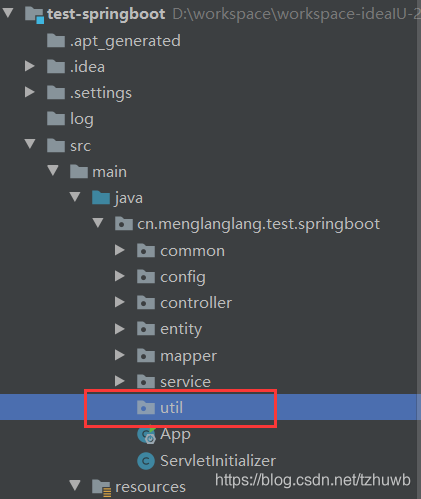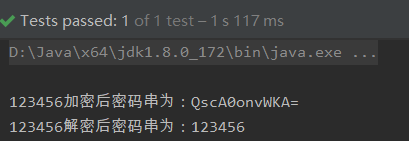随着信息安全防护措施的提升,越来越多的项目要求项目中的密码不能有明文,都需要加密,配置文件中相关的密码也不例外,都需要进行加密处理后再配置。那如何对 SpringBoot 配置文件中的明文密码进行加密呢?这篇就以前面的数据源配置为例,对数据库用户对应的密码进行加密,加密方式为自定义算法加密。
这篇开始,由于自己也逐渐去学习并适应 IDEA 工具的开发,所以把项目工程从 STS 开发环境迁移到了 IDEA 开发环境。
第一步,创建加密工具类
既然是自定义算法加密,那首先需要有个自定义加密解密的方法,可以封装为工具类放到项目中,至于加密算法的复杂性,可以随项目要求定义,这里就拿个简单的加密方法做测试。由于没有对应的包,这里先建个工具类的包util,如图:

创建加密解密工具类 Base64Util.java,主要代码如下:
package cn.menglanglang.test.springboot.util;
import javax.crypto.Cipher;
import javax.crypto.SecretKey;
import javax.crypto.SecretKeyFactory;
import javax.crypto.spec.DESKeySpec;
import java.security.InvalidKeyException;
import java.security.NoSuchAlgorithmException;
import java.security.spec.InvalidKeySpecException;
import java.util.Collection;
import java.util.Map;
/**
* @author 孟郎郎
* @version 1.0
* @desc 基于 base64 编码加密解密字符串工具类
* @blog http://www.menglanglang.cn
* @date 2020/7/5 19:20
*/
public class EADcryptUtil {
private static final String DES_ALGORITHM = "DES";
private static final String SECRET_KEY = "DEFAULT_KEY";
/**
* DES默认密钥加密
*
* @param plainData
* @return
* @throws Exception
*/
public static String encryptDES(String plainData) {
return encryptDES(plainData, SECRET_KEY);
}
/**
* DES默认密钥解密
*
* @param secretData
* @return
* @throws Exception
*/
public static String decryptDES(String secretData) {
return decryptDES(secretData, SECRET_KEY);
}
/**
* DES指定密钥加密
*
* @param plainData
* @param secretKey
* @return
* @throws Exception
*/
public static String encryptDES(String plainData, String secretKey) {
if (isObjNull(plainData)) {
return "";
}
Cipher cipher = null;
byte[] buf = null;
try {
cipher = Cipher.getInstance(DES_ALGORITHM);
cipher.init(Cipher.ENCRYPT_MODE, generateKey(secretKey));
buf = cipher.doFinal(plainData.getBytes());
} catch (Exception e) {
e.printStackTrace();
return "";
}
return Base64Utils.encode(buf);
}
/**
* DES指定密钥解密
*
* @param secretData
* @param secretKey
* @return
* @throws Exception
*/
public static String decryptDES(String secretData, String secretKey) {
if (isObjNull(secretData)) {
return "";
}
Cipher cipher = null;
byte[] buf = null;
try {
cipher = Cipher.getInstance(DES_ALGORITHM);
cipher.init(Cipher.DECRYPT_MODE, generateKey(secretKey));
buf = cipher.doFinal(Base64Utils.decode(secretData.toCharArray()));
} catch (Exception e) {
e.printStackTrace();
return "";
}
return new String(buf);
}
/**
* 获得密钥
*
* @param secretKey
* @return
* @throws NoSuchAlgorithmException
* @throws InvalidKeyException
* @throws InvalidKeySpecException
*/
private static SecretKey generateKey(String secretKey)
throws NoSuchAlgorithmException, InvalidKeyException,
InvalidKeySpecException {
SecretKeyFactory keyFactory = SecretKeyFactory
.getInstance(DES_ALGORITHM);
DESKeySpec keySpec = new DESKeySpec(secretKey.getBytes());
keyFactory.generateSecret(keySpec);
return keyFactory.generateSecret(keySpec);
}
/**
* 判断字符串是否为空,集合是否为空,数组是否为空 返回true为空
*/
@SuppressWarnings("rawtypes")
public static boolean isObjNull(Object obj) {
if (obj == null)
return true;
if (obj instanceof CharSequence)
return ((CharSequence) obj).length() == 0;
if (obj instanceof Collection)
return ((Collection) obj).isEmpty();
if (obj instanceof Map)
return ((Map) obj).isEmpty();
if (obj instanceof Object[]) {
Object[] object = (Object[]) obj;
if (object.length == 0) {
return true;
}
boolean empty = true;
for (int i = 0; i < object.length; i++) {
if (!isObjNull(object[i])) {
empty = false;
break;
}
}
return empty;
}
return false;
}
static class Base64Utils {
static private char[] alphabet = "ABCDEFGHIJKLMNOPQRSTUVWXYZabcdefghijklmnopqrstuvwxyz0123456789+/="
.toCharArray();
static private byte[] codes = new byte[256];
static {
for (int i = 0; i < 256; i++)
codes[i] = -1;
for (int i = 'A'; i <= 'Z'; i++)
codes[i] = (byte) (i - 'A');
for (int i = 'a'; i <= 'z'; i++)
codes[i] = (byte) (26 + i - 'a');
for (int i = '0'; i <= '9'; i++)
codes[i] = (byte) (52 + i - '0');
codes['+'] = 62;
codes['/'] = 63;
}
/**
* 将原始数据编码为base64编码
*/
static public String encode(byte[] data) {
char[] out = new char[((data.length + 2) / 3) * 4];
for (int i = 0, index = 0; i < data.length; i += 3, index += 4) {
boolean quad = false;
boolean trip = false;
int val = (0xFF & (int) data[i]);
val <<= 8;
if ((i + 1) < data.length) {
val |= (0xFF & (int) data[i + 1]);
trip = true;
}
val <<= 8;
if ((i + 2) < data.length) {
val |= (0xFF & (int) data[i + 2]);
quad = true;
}
out[index + 3] = alphabet[(quad ? (val & 0x3F) : 64)];
val >>= 6;
out[index + 2] = alphabet[(trip ? (val & 0x3F) : 64)];
val >>= 6;
out[index + 1] = alphabet[val & 0x3F];
val >>= 6;
out[index + 0] = alphabet[val & 0x3F];
}
return new String(out);
}
/**
* 将base64编码的数据解码成原始数据
*/
static public byte[] decode(char[] data) {
int len = ((data.length + 3) / 4) * 3;
if (data.length > 0 && data[data.length - 1] == '=')
--len;
if (data.length > 1 && data[data.length - 2] == '=')
--len;
byte[] out = new byte[len];
int shift = 0;
int accum = 0;
int index = 0;
for (int ix = 0; ix < data.length; ix++) {
int value = codes[data[ix] & 0xFF];
if (value >= 0) {
accum <<= 6;
shift += 6;
accum |= value;
if (shift >= 8) {
shift -= 8;
out[index++] = (byte) ((accum >> shift) & 0xff);
}
}
}
if (index != out.length)
throw new Error("miscalculated data length!");
return out;
}
}
}第二步:测试加密方法正确性
使用工具类中的加密解密方法,测试加密后的密串,能否被解密函数正常解析。
package cn.menglanglang.test.springboot;
import cn.menglanglang.test.springboot.util.EADcryptUtil;
import org.junit.Test;
/**
* @author 孟郎郎
* @version 1.0
* @desc
* @blog http://www.menglanglang.cn
* @date 2020/6/17 22:45
*/
public class TestMethod {
@Test
public void test() {
System.out.println("123456加密后密码串为:" + EADcryptUtil.encryptDES("123456"));
System.out.println("123456解密后密码串为:" + EADcryptUtil.decryptDES("QscA0onvWKA="));
}
}输出结果为:

第三步:修改原明文密码配置
用测试时得到的加密串,替换原明文密码,如下图所示。

替换为如下图所示,注意在实际开发中,把配置文件中的明文密码部分删除掉,不然加密白做了!!!

第四步:修改密码设值部分
在上一篇配置多数据源的文章中,提到了配置多数据源的类 FirstDataSourceConfig 和 SecondDataSourceConfig,分别修改类中密码部分如下:


第五步:启动项目测试
重新启动项目,测试是否能够连上数据库,页面查询数据是否正常。


到此,通过自定义算法加密数据库密码大功告成。






















 2586
2586











 被折叠的 条评论
为什么被折叠?
被折叠的 条评论
为什么被折叠?








